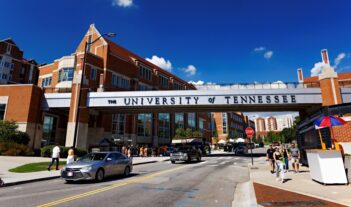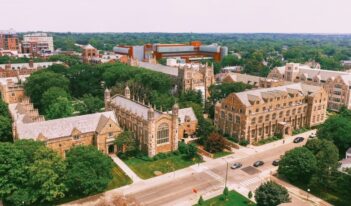
Proposed rule would extend free lunch to all students in qualifying schools.
Close to fifty million students enrolled in U.S. schools are eligible for free or reduced-priced lunch, according to the National Center for Education Statistics. But even though the federal government subsidizes school lunches, providing free and reduced lunches to students can still be burdensome for schools.
Under current federal regulations, many students receive free or reduced-priced lunch only after their schools have verified their eligibility through a household application. Distributing, collecting, and organizing these applications often imposes a high administrative burden on school districts. Although schools have the option of applying funds received through the government lunch subsidy program to cover administrative costs, schools have still reported being burdened by the logistical expenses associated with implementing the lunch assistance program. For example, Dallas ISD, a Texas school district with eighty-nine percent of its students qualifying for free or reduced-priced lunch, reportedly spends $300,000 a year in administrative costs associated with its free and reduced lunch program.
These costs may be substantially reduced if the Department of Agriculture, Food and Nutrition Service’s (FNS) proposed rule is finalized in the coming months. The agency’s proposed rule would establish a community eligibility option for schools. This option would provide a way for school districts with a high volume of students eligible for free or reduced-priced lunch to forego the application process altogether by providing free meals to the entire student body while receiving a government subsidy based on a generous estimate of the portion of the student body that would be eligible for “free” lunch.
Under the proposed regulation, schools where at least forty percent of students are currently exempt from the lunch application process because they are identified as being vulnerable to food insecurity and, thus, are directly certified for free lunch, may elect the community eligibility option. These types of “identified students” who categorically qualify for free lunch include homeless, migrant, or foster children, as well as students who qualify for other federally funded food assistance programs.
Once schools have met the forty percent threshold, the government would calculate its reimbursement to a school by multiplying the school’s actual percentage of “identified students” by 1.6—an equation that is intended to estimate the total percentage of free and reduced-lunch eligible students within a student body. The school would be reimbursed at the “free” lunch rate for the entire resulting percentage of students, regardless of whether the estimate is higher than the percentage of students who would be eligible for free lunch under the traditional application method.
The proposed rule, however, would not provide additional federal funds for the school to provide free lunches to the remainder of the student body falling outside of the percentage of students determined from the reimbursement equation to be eligible for free lunch. These non-free lunch students would be reimbursed at the “paid” rate—the meager government subsidy that schools currently receive to cover the administrative costs of students who pay full price for their lunches. Despite having to incur the cost of providing free lunch to all students at a less than 100 percent reimbursement rate, many school districts are confident that the Community Eligibility option will ultimately be more affordable.
“It’s about paperwork and efficiencies,” Dora Rivas, Dallas ISD’s executive director of food and child nutrition services, told the Dallas Morning News. The school district plans to exercise the community eligibility option and will, as a result, eliminate forty temporary positions associated with the administrative needs of distributing free and reduced-priced lunches.
Schools receive substantial funding based on the number of students identified that are qualified to receive free and reduced-priced lunch. “It’s about millions of dollars in school funding,” John Walker, interim director of Food and Nutrition Services for Baltimore City Public Schools, recently told a news source. Walker stated that schools in Maryland receive around $5,000 per qualifying child, amounting to over $323 million of funding, more than a quarter of the operating budget for schools in the state. The Community Eligibility option would allow school districts to reduce the administrative costs associated with operating the lunch program, freeing up even more of this subsidized funding for other uses.
A school meeting the regulatory threshold would be able to exercise the community eligibility option for a four-year cycle before needing to reapply, and would be guaranteed the pre-determined reimbursement rate for all 4 years, even if their percentage of identified students dropped. Once a school elects to participate in the community eligibility option, it will be required to provide free lunch for all students for the entire four-year cycle and will be monitored by school district boards, more broadly known as local education agencies (LEA). LEAs will count the number of reimbursable meals served daily. An LEA may also elect for a group of qualifying schools to participate in the community eligibility option.
FNS has incrementally phased in the community eligibility option to qualifying schools in several states over the past few years through memoranda and guidance. The proposed rule would extend the community eligibility option to all schools nationwide in the coming year.
During the phase-in period, some qualifying school districts and local educational agencies expressed reluctance to choose the community eligibility option. Under the proposed rule, a school electing the community eligibility option would be prohibited from collecting applications from students in connection with the free and reduced lunch program. In the past, these applications have served the dual purpose of providing valuable demographic and socioeconomic data for districts, in addition to determining students’ eligibility for free lunch. If a school wished to continue to collect this useful data from its students, it would need to create its own information collection system that is entirely unrelated to the school’s lunch program and is independently facilitated and funded by the school.
One report by Joy Pullmann, a research fellow from The Heartland Institute, expresses fear that the community eligibility option would be a wasteful use of government resources, forcing participating schools to provide free meals to many students who do not need them. Given the recent government shutdown and continuing uncertainty in the government, Pullmann doubts the wisdom of “creat[ing] another entitlement for families that can afford to provide lunches for their children.”
The proposed rule would amend current FNS eligibility regulations for free and reduced-priced meals under the National School Lunch Program and the School Breakfast Program. The community eligibility option incorporates part of the Healthy Hunger-Free Kids Act passed in 2010. The Act, which amended the Richard B. Russell National School Lunch Act, sought to give schools with a substantial population of students from low-income households the option to eliminate the application process on its campuses.



